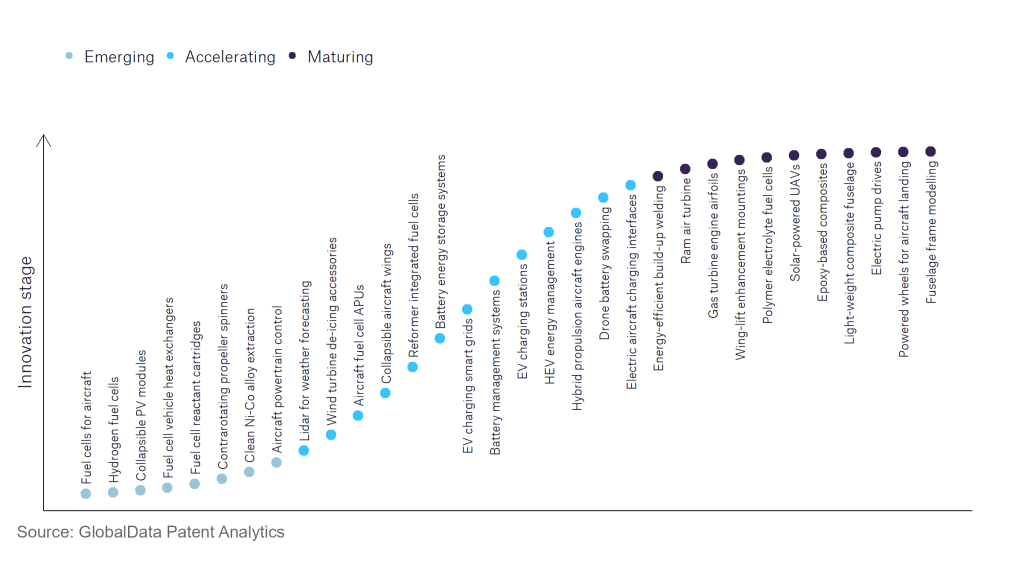The aerospace and defence industry continues to be a hotbed of innovation, with activity driven by the need to lower operational costs, larger consumer trends, and electrification, and growing importance of technologies such as hydrogen and electric aircraft and advanced materials. In the last three years alone, there have been over 174,000 patents filed and granted in the aerospace and defence industry, according to GlobalData’s report on Environment Sustainability in Aerospace, Defence & Security: Battery energy storage systems. Buy the report here.
However, not all innovations are equal and nor do they follow a constant upward trend. Instead, their evolution takes the form of an S-shaped curve that reflects their typical lifecycle from early emergence to accelerating adoption, before finally stabilising and reaching maturity.
Identifying where a particular innovation is on this journey, especially those that are in the emerging and accelerating stages, is essential for understanding their current level of adoption and the likely future trajectory and impact they will have.
180+ innovations will shape the aerospace and defence industry
According to GlobalData’s Technology Foresights, which plots the S-curve for the aerospace and defence industry using innovation intensity models built on over 262,000 patents, there are 180+ innovation areas that will shape the future of the industry.
Within the emerging innovation stage, hydrogen fuel cells, aircraft powertrain control systems, and fuel cells for aircraft are disruptive technologies that are in the early stages of application and should be tracked closely. EV charging stations, collapsible aircraft wings, and electric aircraft charging interfaces are some of the accelerating innovation areas, where adoption has been steadily increasing. Among maturing innovation areas are fuselage frame modelling and powered wheels for aircraft landing, which are now well established in the industry.
Innovation S-curve for environmental sustainability in the aerospace and defence industry

Battery energy storage systems is a key innovation area in environmental sustainability
Battery storage, or battery energy storage systems (BESS), are devices that enable energy from renewables, such as solar and wind, to be stored and then released when customers need power the most.
GlobalData’s analysis also uncovers the companies at the forefront of each innovation area and assesses the potential reach and impact of their patenting activity across different applications and geographies. According to GlobalData, there are 10+ companies, spanning technology vendors, established aerospace and defence companies, and up-and-coming start-ups engaged in the development and application of battery energy storage systems.
Key players in battery energy storage systems – a disruptive innovation in the aerospace and defence industry
‘Application diversity’ measures the number of different applications identified for each relevant patent and broadly splits companies into either ‘niche’ or ‘diversified’ innovators.
‘Geographic reach’ refers to the number of different countries each relevant patent is registered in and reflects the breadth of geographic application intended, ranging from ‘global’ to ‘local’.
Patent volumes related to battery energy storage systems
| Company | Total patents (2021 - 2023) | Premium intelligence on the world's largest companies |
| Berkshire Hathaway | 17 | Unlock Company Profile |
| Boeing | 15 | Unlock Company Profile |
| Meta Platforms | 14 | Unlock Company Profile |
| Saildrone | 13 | Unlock Company Profile |
| Shadecraft | 10 | Unlock Company Profile |
| CEA | 9 | Unlock Company Profile |
| Lockheed Martin | 8 | Unlock Company Profile |
| Walmart | 8 | Unlock Company Profile |
| HADAL | 6 | Unlock Company Profile |
| Airbus | 6 | Unlock Company Profile |
| EchoStar | 5 | Unlock Company Profile |
Source: GlobalData Patent Analytics
Amongst aerospace and defence companies, Boeing is a leading patent filer in battery energy storage systems. The company is invested in improving the efficiency of onboard electrical systems to recue wastage and power usage onboard flights. Other key patent filers include Lockheed Martin and Airbus.
In terms of application diversity, Boeing leads the pack. Lockheed Martin and Airbus are in second and third place, respectively. Regarding geographical reach, Airbus holds the top position, followed by Boeing and Lockheed Martin.
Battery management systems are essential components of onboard electrical systems on aircraft, and therefore essential components for efficient modern aircraft.
To further understand the key themes and technologies disrupting the aerospace and defence industry, access GlobalData’s latest thematic research report on Defence.
Data Insights
From

The gold standard of business intelligence.
Blending expert knowledge with cutting-edge technology, GlobalData’s unrivalled proprietary data will enable you to decode what’s happening in your market. You can make better informed decisions and gain a future-proof advantage over your competitors.



